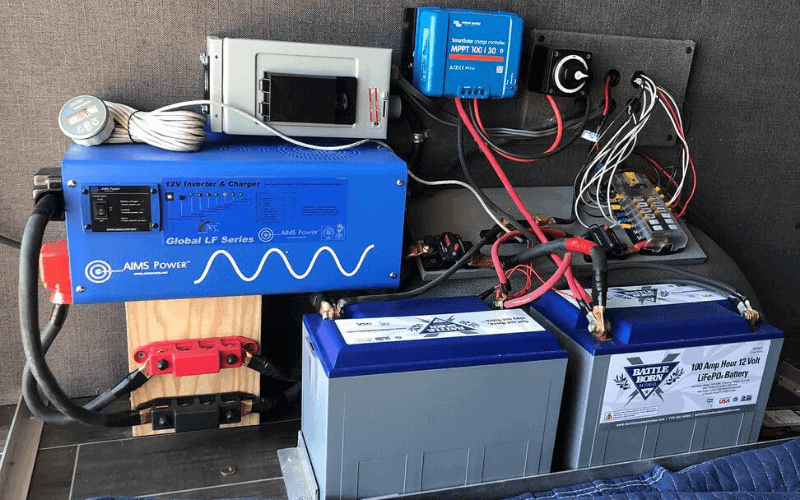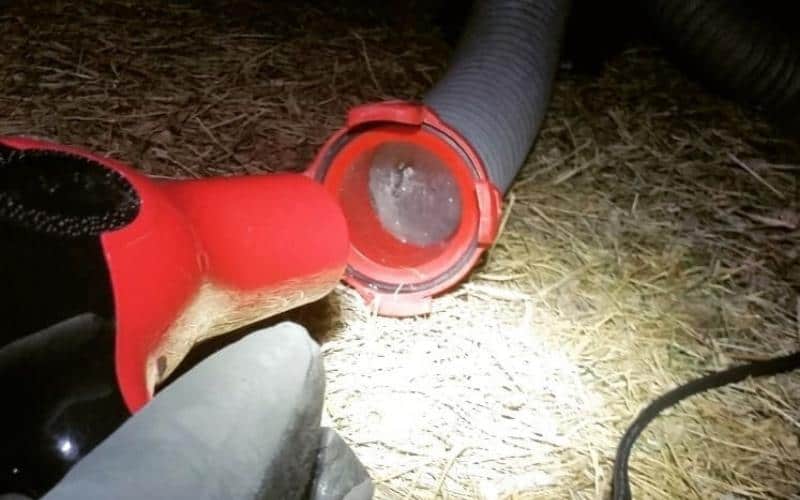Finding the right amenities to fit within the compact space of a camper is crucial for comfort and convenience.
Among these, the challenge of keeping your clothes clean while on the move can seem daunting.
This is where the role of a portable washing machine for RVs becomes indispensable.
Having personally tested numerous models to uncover the best portable washing machines for campers, I’ve discovered that not all machines are created equal.
Each has its own set of features catering to different needs, from size to efficiency and beyond.
The standout for me, which I can confidently label as the best overall, is the Giantex Full-Automatic Portable Washing Machine.
Its balance of size, efficacy, and user-friendliness propels it to the top of the list.
Whether you’re a weekend warrior or a full-time RV dweller, this machine can significantly ease your laundry woes.
Based on my experience, the top portable washing machines are:
- Giantex Full-Automatic Portable Washing Machine: Best overall for its balance of efficiency, size, and ease of use.
- Garatic Portable Compact Mini Twin Tub Washing Machine: Ideal for those who need to multitask with a dual tub design.
- Lavario Manual Non-Electric Portable Clothes Washer: Perfect for campers looking to conserve energy and water.
- COSTWAY Mini Washing Machine with Spin Dryer: A great choice for small spaces and quick drying times.
- Giantex Mini Compact Twin Tub Washing Machine: Excellent for users needing a compact yet effective washing solution.
1: Best Overall: Giantex Full-Automatic Portable Washing Machine
This Giantex washing machine looks a lot like your regular top-loading washer…if has been hit with a shrink ray!
It features a stainless steel tub and a clear lid that makes it easier to monitor the water level during the cycle.
It allows you to load nearly 10 pounds of clothes in a single load and select from 10 pre-programmed settings.
It also includes a child lock and a clear LED display to help you track how much time is remaining.
You will also love the adjustable feet on the bottom of this machine.
This can be critical for RV washers because your rig will often be slightly slanted in a different direction every time you move and find a new campsite.
This machine also comes with a built-in drain pump that automatically drains the tub during the spin cycle.
Plus, it includes an air-dry feature that eliminates having to hang your clothes out to dry after each cycle.
It also comes with a 39.4-inch water inlet pipe and a 78.8” water outlet pipe that provides you with some flexibility when setting it up in your RV.
Things We Like
Things We Don’t Like
2: Best Twin Tub Design: Garatic Portable Compact Mini Twin Tub Washing Machine
The Garatic Twin Tub washer offers as close to the same functionality as your residential washer and dryer as possible.
The twin tub design will also save you time by allowing you to start a second wash cycle while you spin the first cycle dry.
This model features a single cycle option for washing and a secondary timer for drying.
The maximum wash timer runs for up to 15 minutes while the drying timer can be set for a maximum of 5 minutes per cycle.
The key here is that those shorter cycle times are designed to help you save water when you are camping.
While they might shock you at first (compared to the cycle times for residential washers and dryers), the goal here is to find a happy medium between living in perpetually dirty clothes and running out of water after a single wash cycle.
The body of this machine is completely plastic, which helps to eliminate parts that may rust or corrode over time.
It is also one of the lightest and most compact options for smaller RVs or camper vans.
Things We Like
Things We Don’t Like
3: Best Non-Electric Option: Lavario 1214 Manual Non-Electric Clothes Washer
If you are seeking an option that doesn’t require a power source, then the Lavario model is your best bet.
This is probably the best option for overlanding or remote camping because it won’t drain your battery excessively like many of the others will.
This is technically a top-loading design, but it is quite unique. It basically features a five-gallon bucket that you fill with water and your preferred detergent (we hope you choose something biodegradable!).
Then, you load your clothing into the basket and secure the lid. The basket slides down into the bucket and you proceed to wash your clothes with an easy up-and-down motion.
After a few minutes, remove the clothing basket and dump the soiled water.
Finally, add fresh water and repeat the process to adequately rinse the soap off your clothes.
On average, this washer will require roughly 10 gallons of water per cycle. You will also need to wring your clothing dry and then hang it to complete your process.
For convenience, the wash bucket has a drain cap at the bottom so that you don’t have to lift and dump it when it is full of water.
Plus, the bottom boasts rubberized feet to prevent it from slipping and spilling your clothes out onto the dirty ground.
Things We Like
Things We Don’t Like
4: Best Budget-Friendly: COSTWAY Mini Washing Machine with Spin Dryer
For those of you that want to experiment with whether a portable washer makes sense for you without spending an arm and a leg, I’d highly recommend checking out the COSTWAY Mini Washing Machine.
It is the most affordable model on our list and also one of the most lightweight.
It is designed for smaller loads but it does include a spin cycle so that you don’t have to deal with sopping wet clothing once the wash cycle is finished.
The wash cycle timer can be set for up to 10 minutes and the spin cycle timer allows you to set to a maximum interval of 5 minutes.
Just like the Garatic model, these short timers are designed to encourage water savings in camp settings.
This option also features a clear lid for monitoring loads and provides energy savings due to its compact design.
It also comes with a drainage tube that empties the tub between cycles, but this model will also need to be filled by hand from an external source.
Things We Like
Things We Don’t Like
5: Best For Larger Loads: Giantex Mini Compact Twin Tub Washing Machine
The Giantex Twin Tub Washer is probably the most family-friendly model we have found thus far.
It has an extra-large load capacity and the twin tub design makes it more efficient to get multiple loads done in an afternoon.
This unit also allows you to run either a “normal” or a “soft” wash cycle.
So it will be better for those of you worried about damaging your delicates in one of these portable machines.
The third setting is the “drain” setting for emptying the tubs between cycles.
It also boasts a wash timer and a spin dry timer to keep you honest in doing quick, efficient loads.
The wash timer can be set to a maximum of 15 minutes and the dry timer allows for quick cycles of up to 5 minutes at a time.
Like its Giantex cousin that we covered earlier, the Mini Compact comes with a water inlet and a drainage hose.
That makes popping clothes in and programming your desired setting easy and reduces the need to worry about overfilling the wash tub.
Things We Like
Things We Don’t Like
Things You Should Look For When Buying A Portable Camping Washing Machine?
The features and specifications that you need to look for when shopping for a portable camp washer will depend on your rig, family size, and several other important factors.
So we will use this buying guide to break down some of those factors and help you decide which of the above machines will best meet your needs.
Dimensions and Load Capacity
These two factors go hand-in-hand because you will need more space for a washer if you want to be able to run larger loads.
So the logical place to begin is to consider where you will set one of these up or store it in your RV.
Some people will actually set these up outside while they are camping so that they don’t take up space inside.
Still, that will require that you have enough storage space to fit it safely in one of your RV’s underneath compartments.
If you have a larger 5th wheel or luxury class A diesel pusher motorhome that came with a washer-dryer prep, then that would be the most logical space to install one of these machines.
Measure that space to know how large of a machine you can fit there.
Always be sure to leave a little wiggle room behind, in front, and on the sides of the machine.
This will allow you to more easily run hoses and fetch those pesky socks that can’t make it straight from the laundry basket and into the washer.
Also, keep in mind how you have already been using that space. If, for example, you have been using it to hang long dresses, you may not want a very tall unit that compromises your hanging space.
On the note of load capacity, this will also depend on how many people are typically traveling in your rig.
Family-sized load capacities will require more space to store them inside your rig, but can ultimately save you time and water in the long run.
Power Requirements
Many portable washers must be plugged into an AC outlet to function. Some run on DC, but the majority are designed for the wall outlets on the interior or exterior of your RV.
There are, as you have now seen, also portable options that rely solely on human power.
These options require more time and energy on your part, but they can be great if you don’t typically camp in traditional campgrounds.
Keep in mind that you will either need to be running your generator or be plugged into shore power to run an electric washing machine in your RV.
And you will also need to be mindful of the other appliances you turn on when you already have a load of laundry going if you want to avoid overloading a circuit.
Fill Requirements
Some of these models require you to fill the tub with water from an external source. Others allow you to hook them up to a water hose for more direct filling.
The latter seems to be much more convenient for full-time RVers or folks that are going to be running a lot of loads in their new washer.
On the other hand, it will require a more extensive installation process and you can be limited by the length of the hoses that the unit comes with.
That is why many folks that only use their machines a few times a year will prefer a model that you load with water by hand.
It really isn’t that difficult to do and also keeps your unit more mobile when you do need to move it.
Drain Hose Length
If you plan on setting your portable machine up outside of your RV, you don’t have to worry as much about the length of your drain hose.
You will be able to set it up somewhere so that it naturally drains out and away from your campsite.
For the rest of you that want to set up a unit inside your RV, drain hose length is super important.
If your rig already has a washer-dryer prep, you just need enough drain hose to connect to the outlet that will drain water into your rig’s grey water tank.
If you have an older RV without a washer-dryer prep, you may need to get more creative.
I’ve seen people cut outlets in the side of their rigs so that they can drain their washer that way.
While that is possible, the best method is simply to set it up in your bathtub.
Then, you can easily drain the tub into your grey water holding tank no matter how long the washer’s drain hose is.
Noise Output
While I do not really suggest trying to do laundry while you (and the rest of your family is sleeping), noise output may be a priority for you for other reasons.
The good news is that most of these portable washer units emit somewhere between 40 and 80 decibels, on average.
For comparison’s sake, that ranges from the average dull hum of lights or fans in the quietest room in your house (40 decibels) to the conglomeration of sounds at a busy crossroads in your neighborhood.
If you are really looking for a particularly quiet machine, you will need to do a little more digging.
As a general threshold, however, you should look for a model that emits less than 50 decibels during its heaviest mode of operation.
Frequently Asked Questions
Buying one of these machines is all fine and dandy, but it will not do you much good unless you know how to use it.
So let’s address that issue (and some of the other most frequently asked questions about camp washers) in our final section.
How to use a portable washing machine?
The process differs for each model but the basics stay the same. Load your clothes, fill it with water and detergent, program your desired setting or timer length, and press start.
Some units require a little more nuance when it comes to learning how much water is enough (and how much is too much!).
Others will require you to monitor them closely to switch into “drain” mode if you add too much soap and it begins to overflow with suds.
Unfortunately, not all of these models come with the most detailed sets of instructions.
So we would encourage you to research YouTube videos related to the specific model you are interested in to learn more about best practices for using them.
How is a portable washer different than a regular RV Washer?
The main difference is size. On average, a full-size washing machine can handle up to 20 pounds of clothing and is usually nearly four feet tall.
Compare that to the dimensions and load capacities of the compact camp washer models and you will find them to be less than half that of a residential washer.
Additionally, portable machines are designed for shorter wash and spin cycles. This is to help you conserve both water and energy when camping or overlanding.
Is it easy to clean a portable washer?
The best way to remove soap residue and the accumulation of other debris from these washers is to run an empty wash cycle with just hot water and white vinegar (it doesn’t take much) every 2-3 months.
Then run another cycle of hot water and baking soda to neutralize the vinegar.
Another great part about these machines is that they are portable! So you can even take them outside to hose and scrub them down if they really need a deep cleaning.
How much does a portable washing machine cost?
The manual camping clothes washer can be found for right around $100 (sometimes a little less), but full automatic models usually will cost somewhere between $150 and $200.
The best portable RV washing machine out there for larger loads (and with extra features) can easily run you more than $300.
Conclusion
When you are going multiple days between showers (which is common for many campers), there is arguably no better feeling than putting on clean clothes.
In addition, having a portable washing machine in your rig makes it so much easier to handle unexpected spills when they inevitably occur.
We hope you enjoyed our reviews of these washers today. In the interest of being more self-reliant and making your camp life easier, we sincerely hope you invest in one.
As always, we also want to sign off by wishing you the healthiest and happiest of RV adventures during the coming season!

![6 Best Portable Washing Machines for RVs in [currentyear]: Expert RV Reviews 1 Portable Washing Machine](https://www.rvingknowhow.com/wp-content/uploads/2021/07/Portable-Washing-Machine-.jpg)
![6 Best Portable Washing Machines for RVs in [currentyear]: Expert RV Reviews 2 Giantex Full-Automatic Washing Machine Portable Compact 1.34 Cu.ft Laundry Washer Spin with Drain Pump, 10 programs 8 Water Level Selections with LED Display 9.92 Lbs Capacity](https://www.rvingknowhow.com/wp-content/uploads/2024/02/319qMjcGiLL._SL500_.webp)
![6 Best Portable Washing Machines for RVs in [currentyear]: Expert RV Reviews 3 Garatic Portable Compact Mini Twin Tub Washing Machine w/Wash and Spin Cycle, Built-in Gravity Drain, 13lbs Capacity For Camping, Apartments, Dorms, College Rooms, RV’s, Delicates and more](https://www.rvingknowhow.com/wp-content/uploads/2024/02/41kIa6lvaL._SL500_.webp)
![6 Best Portable Washing Machines for RVs in [currentyear]: Expert RV Reviews 4 Lavario Portable Clothes Washer (Manual Non-Electric Portable Washing Machine for Camping, Apartments, RV’s, Delicates) (Tan & Black) (Made in the USA)](https://www.rvingknowhow.com/wp-content/uploads/2024/02/31hOdZjj-pS._SL500_.webp)
![6 Best Portable Washing Machines for RVs in [currentyear]: Expert RV Reviews 5 COSTWAY Portable Mini Washing Machine with Spin Dryer, Washing Capacity 5.5lbs, Electric Compact Machines Durable Design Energy Saving, Rotary Controller, Laundry Washer for Home Apartment RV, Blue](https://www.rvingknowhow.com/wp-content/uploads/2024/02/417OpxvztlL._SL500_.webp)
![6 Best Portable Washing Machines for RVs in [currentyear]: Expert RV Reviews 6 Giantex Portable Mini Compact Twin Tub Washing Machine 20lbs Washer Spain Spinner Portable Washing Machine, Blue+ White](https://www.rvingknowhow.com/wp-content/uploads/2024/02/31HHfx82aJL._SL500_.webp)
![10 Best Travel Trailers Under $10,000 Price in [currentyear]. Affordable RVs for Sale 7 The Best Affordable Travel Trailers For Under $10,000](https://www.rvingknowhow.com/wp-content/uploads/2020/07/The-Best-Affordable-Travel-Trailers-For-Under-10000-150x150.jpg)
![8 Best SUVs for Towing Travel Trailer in [currentyear]: Top Rated SUV for Towing 8 Best SUVs For Towing A Travel Trailer](https://www.rvingknowhow.com/wp-content/uploads/2020/05/Best-SUVs-For-Towing-A-Travel-Trailer-150x150.jpg)


